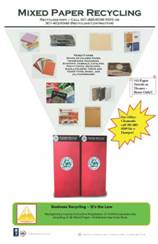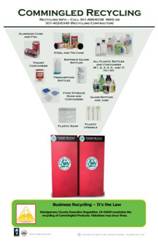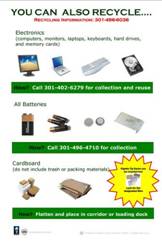 |
 |
|||
|
| If the current recycling rate increases by... | Then NIH’s annual solid waste disposal costs will be reduced by... |
10% |
$51,000 |
35% |
$178,000 |
50% |
$255,000 |
Generate Revenue from Recyclable Materials
On average, NIH receives the following for the value of recyclables on a monthly basis:
Cardboard |
$4,500 |
Mixed Paper |
$1,500 |
Scrap Metal |
$2,500 |
Wood Pallets |
$1,300 |
This equates to nearly $120,000 per year for the value of these recyclables.
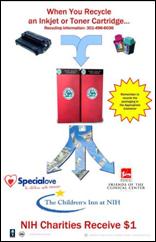
How does recycling benefit NIH Charities?
For every usable inkjet or toner cartridge that is recycled, $1.00 is donated to NIH Charities (The Children's Inn at NIH, Special Love for Children with Cancer-Camp Fantastic, Friends of the Clinical Center). Almost $3,500 was donated through this effort in 2007 and so far over $2,000 has been donated in 2008.
A charitable donation is also made on behalf of Garment Recovery Systems (GRS) for the recycling of Tyvek garments. A recent donation from GRS in the amount of $280 was made to the Children’s Inn.
How does recycling benefit the environment?
Recycling reduces the use of natural resources by reusing materials:
- 94% of the natural resources used by Americans are non-renewable. Non-renewable, natural resources use has increased from 59% in 1900 and 88% in 1945.
- Recycling saves non-renewable resources. For example, by not recycling paper 80% more wood will need to be harvested by 2010 to meet growing paper consumption demands. However, through active paper recycling, only 20% more wood will need to be harvested by 2010.
- It takes 95% less energy to recycle aluminum than it does to make it from raw materials.
- Making products from recyclables results in energy savings. Recycled steel saves 60% production energy, recycled newspaper 40%, recycled plastics 70%, and recycled glass 40%.
- Using scrap steel instead of virgin ore to make new steel takes 40% less water and creates 97% less mining waste.
How does recycling benefit the economy?
- Incinerating 10,000 tons of waste creates 1 job, while landfilling the same amount creates 6 jobs. Recycling the same 10,000 tons creates 36 jobs!
- The National Recycling Coalition reports that recycling has created 1.1 million jobs, $236 billion in gross annual sales, and $37 billion in annual payroll.
- By meeting the state’s 50% recycling goal, California is expected to create about 45,000 recycling jobs, compared to 20,000 new jobs slated to be created for the manufacturing sector.
- Massachusetts employs more than 9,000 people in more than 200 recycling enterprises. About half of these jobs are in the recycling-based manufacturing sector. These businesses represent more than half a billion dollars in value to the state's economy.
What are NIH’s current recycling levels?
- NIH’s current recycling monthly average is about 40%, which includes both the mandatory and voluntary recyclables.
- The NIH recycling rates as reported to Montgomery County for the mandatory (e.g., mixed paper, commingled, cardboard, and scrap metal) recyclables was about 25% for 2007. The current recycling goal for businesses in Montgomery County is 50%.
- A routine waste audit of Building 13 in June 2007 determined that over 42% of materials found in a solid waste compactor were mandatory recyclables.
- A follow-up audit of Building 13 in July 2008 determined that 38% of solid waste compactor contents were mandatory recyclables, weighing over 2,540 pounds with the majority of it being mixed paper (2,340 lbs).
Zero waste is a fresh approach to waste management and the use of resources. It focuses on a “whole system” approach by going beyond the "end-of-the-line" treatment of waste and promoting the three "R's" of reduce, reuse, recycle. Zero Waste maximizes recycling, minimizes waste, reduces consumption and ensures that products are made to be reused, repaired or recycled back into nature or the marketplace.
Examples of Zero Waste Success in the Business World
- Hewlett-Packard (9,000 employees) is diverting 92-95% of its solid waste, saving almost a million dollars a year in avoided waste disposal costs.
- Toyota claims a 97% zero-landfill status average over its 14 assembly plants.
- Copy-machine maker Ricoh has had a zero-landfill status at its U.S. plants since 2002.
- Anheuser-Busch has recycled 99% of the solid waste generated at its 12 breweries.
- Subaru claims that 99.8% of the refuse from its Indiana plant is diverted from going to landfills by recycling and reusing parts.
Does NIH have recycling plans for the future?
- Individual recycling at workstations by all employees
- Composting of food scraps from cafeterias
- Composting of animal bedding
- Promote zero waste for special events held on campus
- Construction debris recycling
- Reduce waste through green purchasing
Why is recycling important to future generations?
Natural resources are being depleted and landfills are being filled at an increasing rate. Our current system of production, consumption and disposal has become unsustainable. It is imperative for everyone—from individuals to large organizations—to rethink our ideas and our relationship to trash disposal. By reducing the amount of trash produced and reusing existing materials, we can all make a difference by protecting the environment, conserving natural resources, and sustaining the planet for future generations.
Related Links
- Montgomery County Recycling Regulations
- NIH Waste Disposal Guide
- Recycling in Maryland
- Recycling Improvements at NIH
- NIH Receives White House Electronics Recycling Award -
 NIH Record - June 29, 2007
NIH Record - June 29, 2007 - NIH Celebrates ‘America Recycles Day’ Nov. 15 -
 NIH Record - December 1, 2006
NIH Record - December 1, 2006
ARTICLES

|
 National Institutes of Health (NIH) 9000 Rockville Pike Bethesda, Maryland 20892 |
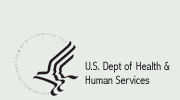 |
|
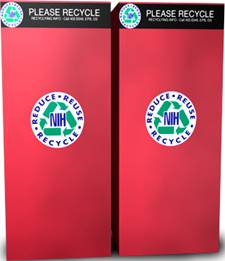 NIH RECYCLING PROGRAM
NIH RECYCLING PROGRAM